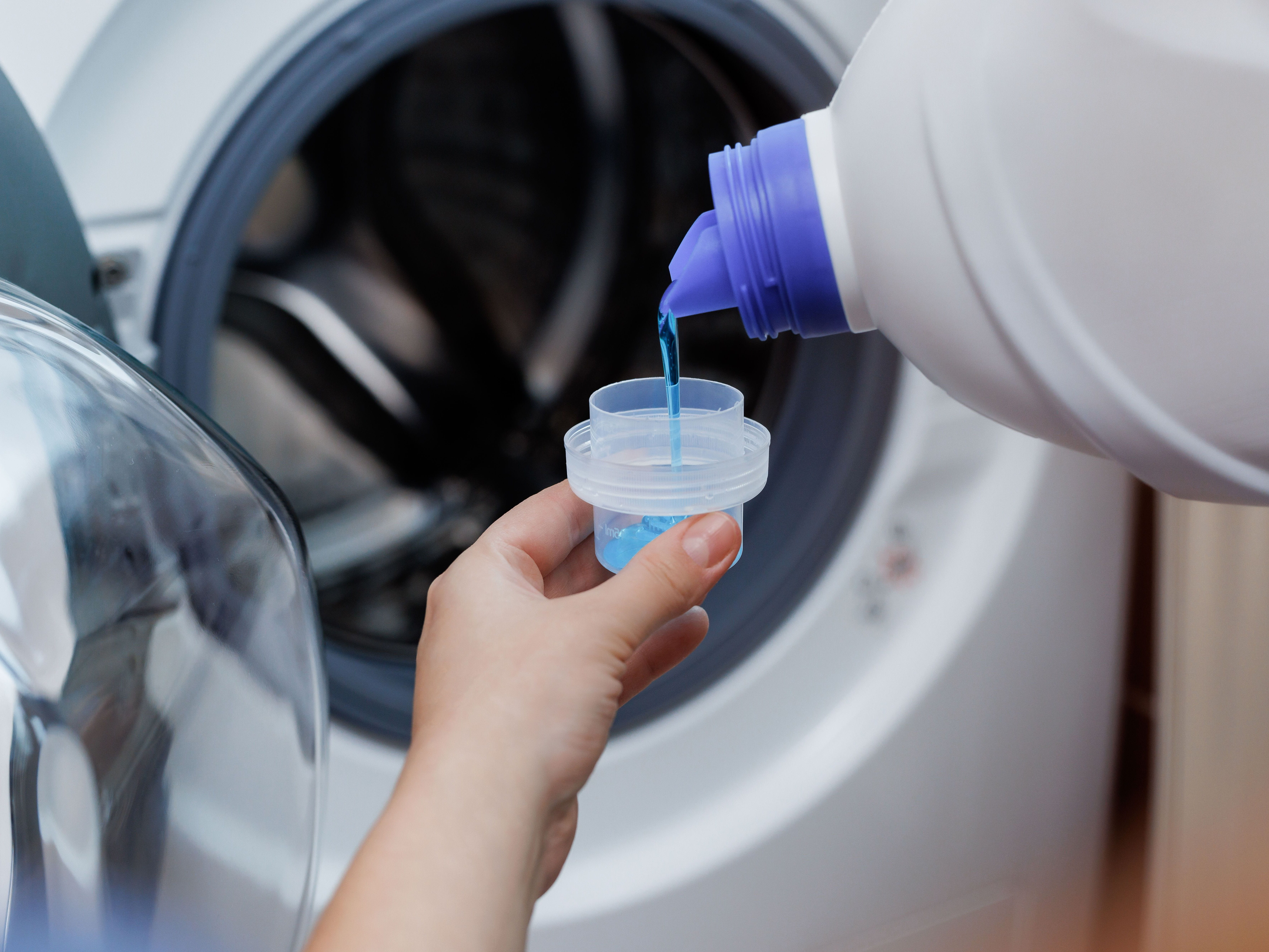Liquid Laundry Detergent: Is It Harmful?

The Bottom Line
Liquid laundry detergent, a common cleaning item found in nearly every home, contains ingredients that may be harmful if mishandled. Detergents in any formulation (liquid, powder, or pods) may cause allergic reactions in some people, ranging mild skin rash to severe difficulty breathing. These reactions usually resolve quickly with treatment.

Is liquid laundry detergent toxic?
Laundry detergents are synthetic soaps manufactured for the intent of cleaning fabric and clothing. Liquid laundry detergents may contain surfactants and enzymes that help break down and remove dirt and stains, emulsifiers to make the product more uniform so it doesn’t separate, borates to improve cleaning action, and bleaches or brighteners to enhance the fabric’s appearance. Fragrances, preservatives, and dyes may also be present in liquid laundry detergents.
Ingestion of laundry detergents commonly causes mouth and throat irritation, coughing or choking, nausea, vomiting, diarrhea and drowsiness or lethargy. Some laundry detergents are strong enough to cause severe effects such as burns to the lining of the throat and difficulty breathing. When the fragrances from laundry detergents are inhaled, they may trigger respiratory symptoms such as coughing and wheezing in sensitive individuals and people with asthma.
When detergent comes into contact with bare skin, it can cause inflammation, irritation, and rash. The actual prevalence of atopic dermatitis (rash) due to laundry detergent is lower than many people believe, likely because the concentration of detergent after the washing process is much lower than if direct contact with a detergent is made. When laundry detergent comes in contact with the eyes, people experience eye pain and irritation, red eyes, conjunctivitis and occasional corneal abrasions.
Ingestion of laundry detergent pods causes more stomach irritation and higher incidence of breathing problems and drowsiness than ingestion of liquid laundry detergent formulations. When the contents of laundry detergent pods get into the eye they can cause eye pain and redness and if they get on the skin they can cause irritation or rash, similar to the symptoms caused by liquid laundry detergents.
How are liquid laundry detergents different than pods?
A laundry detergent pod consists of a concentrated detergent package wrapped in material that allows water to flow in and break apart the pod, releasing the detergent in the wash. They may have liquid or powder soap inside, or a combination of both. They are easy to use and attractively packaged, making them look enticing to young children. Pods may seem “safer” due to their tight, compact packaging. However, the detergent inside contains the same active ingredients as traditional detergents, including stain removers and fragrances, which are toxic if swallowed and can cause skin and eye irritations. Because they are a concentrated formulation, pods are responsible for adverse effects more often than non-pod liquid laundry detergent.
In recent years, manufacturing companies have made efforts to make their product less attractive by using opaque packaging and using locking devices on the container. These changes should help reduce exposure in young curious children.
Is laundry detergent safe to inhale?
Some people are sensitive to specific irritants in liquid detergent fumes, triggering reactions such as asthma or mild breathing difficulties. These fumes might also contribute to declines in overall environmental air quality, which could be responsible for increased incidence of respiratory diseases including asthma.
Biodegradable detergents offer a more environmentally friendly alternative to traditional laundry detergents. Because the traditional “toxic” chemicals are left out of these products, these may be a safer option for people known to have sensitive skin or asthma.
What are the symptoms of a laundry detergent allergy?
An allergy to laundry detergent most often presents as a skin reaction, often taking the form of a red, itchy rash in the armpits and groin areas. This kind of reaction can show up quickly or may develop over time. The rash can typically be treated with over-the-counter steroid creams such as hydrocortisone 1% or oral antihistamines. If the reaction is severe, see your doctor or a healthcare professional. People with asthma or respiratory diseases may be sensitive to certain ingredients and may experience breathing difficulties, which could trigger an asthma attack. Changing your laundry detergent to a dye-free, fragrance-free alternative may help prevent these reactions.
Responding to skin and eye irritation
If someone gets laundry detergent in or around the eyes, there may be itching, burning, stinging, or irritation. Immediately rinse the affected skin or eye(s) with lukewarm water and get expert help from the webPOISONCONTROL online tool and by phone at 1-800-222-1222. Poison Control’s expert guidance is always free, confidential, and available 24 hours a day.
My child might have drunk laundry detergent. What should I do?
If someone swallows laundry detergent, seek medical help right away. Do not make a person throw up unless told to do so by poison control or a health care provider. If you have a question about using laundry detergent safely, help from experts is available through the webPOISONCONTROL online tool and by phone at 1-800-222-1222. Poison Control’s expert guidance is always free, confidential, and available 24 hours a day.
Kit DeMarco, PharmD
Community Pharmacist
Poison Control Media Information
Did you find this page helpful? If so, we need your support. Poison Control is in constant competition with misinformation online. Links to www.poison.org or our webPOISONCONTROL triage tool from other websites and blogs help internet searchers quickly find accurate information and Poison Control’s contact information in an emergency. If you use the content from this page, please provide attribution via a link back to this page, www.poison.org, or https://triage.webpoisoncontrol.org/#!/exclusions. By doing so, you could save a life. Thank you!
Poisoned?
Call 1-800-222-1222 or
Prevention Tips
- Never let detergent directly touch your skin.
- Do not inhale the fumes.
- Use gloves when handling detergent.
- Keep laundry pods out of reach and sight of children.
- Use a double-latched lid to secure laundry pods in the container.
This Really Happened
A 2-year-old child drank some liquid laundry detergent. He vomited 4 times at home and his lips appeared swollen. He was taken to the Emergency Department where he had another episode of vomiting. The child was also drooling heavily and could not swallow his own secretions. An upper endoscopy was performed under general anesthesia. Only gastritis was noted, the child did not have significant burns in the throat or stomach. He was discharged home with proton pump inhibitor therapy for 4 weeks. Upon follow-up 3 days after the ingestion, the child was doing well and eating normally.For More Information
Children and Laundry Products. National Capital Poison Center.
What Happens if a Child Eats a Tide Pod?. National Capital Poison Center.
References
Wright BL, Masuda MY, Ortiz DR, Dao A, Civello B, Pyon GC, Schulze AR, Yiannas JA, Rank MA, Kita H, Doyle AD. Allergies Come Clean: The Role of Detergents in Epithelial Barrier Dysfunction. Curr Allergy Asthma Rep. 2023 Aug;23(8):443-451. doi: 10.1007/s11882-023-01094-x. Epub 2023 May 26. PMID: 37233851; PMCID: PMC10527525.
Norman T, Johnson H, Yu J, Adler BL. Is Laundry Detergent a Common Cause of Allergic Contact Dermatitis? Cutis. 2023 Apr;111(4):172-175. doi: 10.12788/cutis.0748. PMID: 37289694.
Poisoned?
Call 1-800-222-1222 or
Prevention Tips
- Never let detergent directly touch your skin.
- Do not inhale the fumes.
- Use gloves when handling detergent.
- Keep laundry pods out of reach and sight of children.
- Use a double-latched lid to secure laundry pods in the container.
